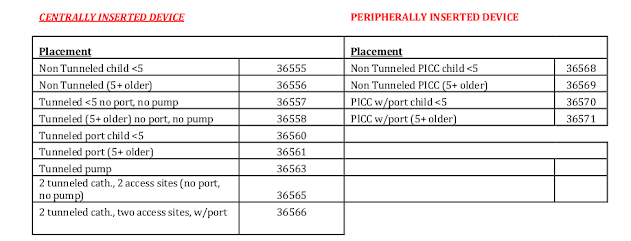Use: For Renal dialysis (kidney disease), cancer treatment (Chemotherapy), etc.
Classification:
2 Types of classification based on the venous access device.
1.Centrally inserted.
2.Peripherally inserted. (PICC line)
1. Centrally inserted:
Insertion site-Jugular vein, Subclavian Vein, femoral vein, or IVC.
Catheter tips must terminate in the Subclavian, Brachiocephalic (Innominate) or iliac veins, SVC, IVC, or RT Atrium.
2. Peripherally inserted:
Insertion site-Basilic vein or cephalic vein.
Catheter must terminate in the Subclavian, Brachiocephalic (Innominate) or iliac veins, SVC, IVC, or RT Atrium.
The procedures involving these types of devices fall into 5 categories.
1.Insertion: Placement of catheter through the new venous access.
2.Repair: Fixing device without replacement of either Catheter port/pump.
3.Partial Replacement: Replacement of only the catheter component associated with a port/ pump (but not the entire device) via the same venous access site.
4.Complete Replacement: Complete replacement means that, removal of the entire device via the same venous access site.
5.Removal: Removal of the entire device.
If an existing central venous access device is removed and a new one placed via separate access site code both procedure.
(Removal of old, if code exists and insertion of a new device).
77001- Fluoroscopy Guidance
76937- Ultrasound Guidance for venous access requiring US evaluation of potential access sites, Documentation selected vessel patency, US visualization of vascular needle entry with permanent recording and reporting.
We have look for the following criteria to the line placements
1. Age
2. Insertion site-Central line or PICC line
3. Non Tunneled or Tunneled
4. with/without Port or pump
5. Guidance- US or Fluoroscopy
Tunneled Catheter:
The vascular catheter is connected to a venous access line that is ‘tunneled’ or placed under the skin.
e.g. - Hickman, Broviac, Groshong Catheter.















0 Comments
Please do not enter any spam link in comment box.